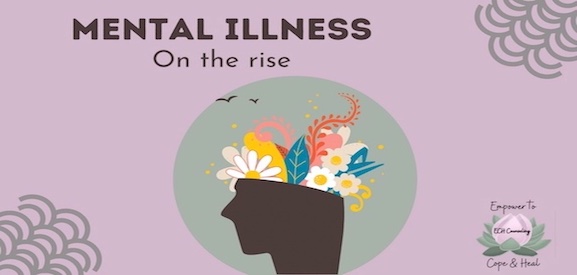
Written by Jennifer Cox LCPC
Obviously, there’s been societal changes caused by the COVID19 pandemic, but some things have also been changing in our society outside even covid. With that we have seen an increase in mental illness rates for various factors:
-Increased Awareness and Diagnosis: There has been a significant improvement in the understanding of mental health issues in recent years which has led to increased awareness and improved diagnostic tools. In the end, this has resulted in more people seeking help and receiving a diagnosis. This is a huge benefit to our society, allowing people to get appropriate treatment.
-Changing Social and Cultural Factors: The increasing prevalence of social media and technology, have led to new stressors and pressures such as feelings of isolation, anxiety, and depression.
-Stigma Reduction: The reduction in stigma surrounding mental health has encouraged more individuals to seek help and openly discuss their mental health challenges. This has led to increased reporting and recognition of mental health issues. Once again a huge benefit, allowing us to talk openly about our concerns without the fear of stigma.
Let’s take a look at what factors could be contributing to the increase among the youth – It is essential to address these factors and promote mental health awareness, early intervention, and access to appropriate support services to help mitigate the increasing mental health issues among youth.
-Academic Pressure: The pressure to excel academically and achieve high grades can lead to stress, anxiety, and burnout in young people.
-Social Media and Technology: The rise of social media and constant exposure to technology has had both positive and negative effects on youth mental health. While it allows for connectivity and access to information, it also leads to increased comparison, cyberbullying, and a constant need for validation.
-Bullying: Bullying, whether in person or online, can have a significant impact on a young person’s mental health. It can lead to feelings of isolation, low self-esteem, anxiety, and depression.
-Unrealistic Expectations: Young people often face high expectations from society, their families, and themselves. The pressure to succeed in various aspects of life, such as academics, career, relationships, and appearance, can lead to feelings of inadequacy and stress.
-Lack of Support: Many young people may not have access to adequate support systems. This lack of support can make it challenging for them to cope with stress and mental health issues.
The rise in mental illness among adults can be attributed to the following several factors:
-Changing societal pressures and expectations: Modern society puts increasing pressure on individuals to succeed, excel, and meet high expectations in various aspects of life such as career, relationships, and finances.
-Financial and economic challenges: Economic instability, job insecurity, and financial stress can contribute to mental health problems.
-Social isolation and loneliness: With the rise of technology and social media, many people are experiencing increased feelings of isolation and loneliness. This lack of social connection can have a negative impact on mental well-being.
-Lack of access to mental health services: Despite the growing recognition of mental health issues, there is still a lack of access to affordable and quality mental health services for many individuals.
In 2023:
-Adults ages 35 to 44 experienced the highest increase in mental health diagnoses—45% reported a mental illness in 2023 compared with 31% in 2019
-Adults ages 18 to 34 still reported the highest rate of mental illnesses at 50% in 2023.
-Adults ages 35 to 44 were more likely to report that money (77% vs. 65%) and the economy (74% vs. 51%) were the factors that cause them significant stress today compared with 2019.
***It is important to note that while there may be an increase in the reported rates of mental illness, it does not necessarily mean that the actual prevalence has increased. Rather, it may reflect improved understanding, awareness, and willingness to seek help. The causes of the rise in mental illness are complex and multifaceted. It is a combination of individual, societal, and environmental factors that contribute to this trend.
Some questions to ask yourself and turn into workable goals:
-Where is the state of your mental health?
-Has your mental health been impacted by any of the above?
-How would you like things to be different?
https://www.ncbi.nlm.nih.gov/pmc/articles/PMC10230139/
https://www.apa.org/news/press/releases/2023/11/
https://www.apa.org/monitor/2023/01/trends-improving-youth-mental-health
Mental illness can impact any of us. So, by promoting understanding, compassion, and support, we can create a society that embraces and empowers those living with mental health conditions. Let us work together to create a world where mental health is prioritized – Where everyone feels safe and supported, empowered on their healing journey towards wellness.
Reach out today at info@echcounseling.com or 815-363-0864

